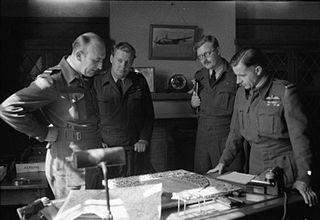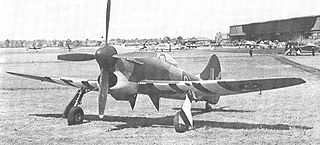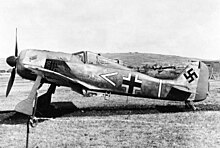
The Focke-Wulf Fw 190, nicknamed Würger (Shrike) is a German single-seat, single-engine fighter aircraft designed by Kurt Tank at Focke-Wulf in the late 1930s and widely used during World War II. Along with its well-known counterpart, the Messerschmitt Bf 109, the Fw 190 became the backbone of the Jagdwaffe of the Luftwaffe. The twin-row BMW 801 radial engine that powered most operational versions enabled the Fw 190 to lift larger loads than the Bf 109, allowing its use as a day fighter, fighter-bomber, ground-attack aircraft and to a lesser degree, night fighter.

No. 303 Squadron RAF, also known as the 303rd "Tadeusz Kościuszko Warsaw" Fighter Squadron, was one of two Polish squadrons that fought during the Battle of Britain along with No. 302 Squadron, of 16 total Polish squadrons during the Second World War. Flying Hawker Hurricanes, the squadron claimed the largest number of aircraft shot down of the 66 Allied fighter squadrons engaged in the Battle of Britain, even though it joined the fray two months after the battle had begun.

Pembrey Sands Air Weapons Range is a Ministry of Defence air weapons range located near the village of Pembrey, Carmarthenshire, 3 miles (4.8 km) northwest of Burry Port and 10.3 miles (16.6 km) south of Carmarthen, Wales. Adjacent to the weapons range site is a former Royal Air Force station known as Royal Air Force Pembrey, or more simply RAF Pembrey, which closed in 1957 and of which part is now in civilian use as Pembrey Airport.

Eugeniusz Horbaczewski was a Polish fighter pilot, a flying ace of World War II, also known as "Dziubek". According to official lists, Horbaczewski was the third highest scoring Polish fighter ace, with 16.5 confirmed kills and one probable kill. He was awarded several decorations, among others Virtuti Militari IV class (posthumously) and V class, four times Polish Cross of Valour, Distinguished Service Order (posthumously) and Distinguished Flying Cross (twice).

Air Vice Marshal William Vernon Crawford-Compton, was a New Zealand flying ace of the Royal Air Force (RAF) during the Second World War. He was officially credited with destroying at least 20 German aircraft.

No. 312 Squadron RAF was a Czechoslovak-manned fighter squadron of the Royal Air Force in the Second World War.
Alois Vašátko DFC was a Czechoslovak artillery officer who became an air force pilot. In the Second World War he was a fighter ace, first in the French Air Force in the Battle of France and then in the Royal Air Force.

The Slovak Resistance Air Force was an Allied air unit which fought against Axis forces in Slovakia and participated in the Slovak National Uprising in August–October 1944.
Jeffrey Kindersley Quill, was a British test pilot who served on secondment with the Royal Air Force and Royal Naval Volunteer Reserve during the Second World War. He was also the second man to fly the Supermarine Spitfire after Vickers Aviation's chief test pilot, Joseph "Mutt" Summers. After succeeding Summers as Vickers' chief test pilot, Quill test-flew every mark of Spitfire. Quill's work on the aircraft aided its development from a promising but untried prototype to become, with the Hawker Hurricane, an instrument of the Royal Air Force's victory in the Battle of Britain. The Spitfire later played a leading role in gaining Allied air superiority over Europe. Quill later wrote two books about the Spitfire.

The Supermarine Spitfire, the only British fighter to be manufactured before, during and after the Second World War, was designed as a short-range fighter capable of defending Britain from bomber attack and achieved legendary status fulfilling this role during the Battle of Britain. According to fighter ace J.E. "Johnnie" Johnson it was the best conventional defensive fighter of the war.

Raymond Hiley Harries, was a Royal Air Force fighter pilot and flying ace of the Second World War. Harries scored 15 victories against enemy aircraft, as well as three shared kills, two probable kills and five damaged during the war. Harries is also credited with the destruction of a V-1 flying bomb.

No. 401 Tactical Fighter Squadron, a.k.a. "City of Westmount" Squadron, is a Royal Canadian Air Force squadron based at CFB Cold Lake. During World War II it was a fighter squadron and is notable for having fought in the Battle of Britain. Postwar, the squadron operated in Canada as an auxiliary squadron, reserve squadron and a helicopter and training squadron. In 2015 it was reactivated as a tactical fighter squadron.

The Focke-Wulf Fw 190 Würger was used by the Luftwaffe during the Second World War in a variety of roles. Like the Messerschmitt Bf 109, the Fw 190 was employed as a "workhorse", and proved suitable for a wide variety of roles, including air superiority fighter, strike fighter, ground-attack aircraft, escort fighter, and operated with less success as a night fighter. It served on all the German fronts: Eastern Front, Western Front, North African Campaign and the Defence of the Reich.

Harvey Nelson Sweetman, was a New Zealand fighter pilot of the Second World War. He flew extensively with No. 486 (NZ) Squadron over Europe and was later commander of No. 3 Squadron. He was credited with shooting down three aircraft and at least eleven V-1 flying bombs.

Air Vice Marshal David Francis William Atcherley, was a senior Royal Air Force officer.

Otto Smik DFC was a Czechoslovak pilot of Slovak-Russian Jew origin who became a fighter ace in the Royal Air Force. He joined the Royal Air Force Volunteer Reserve in July 1940 and was in training until the end of 1942. Between March 1943 and June 1944 he shot down 13 Luftwaffe fighter aircraft probably shot down one more and shared in the shooting down of two others. In July 1944 he shot down three V-1 flying bombs. He became the highest-scoring Slovak fighter ace in the RAF.
Oberleutnant Herbert Schmid was a German World War II pilot who defected to north-east Scotland in May 1943, piloting a German nightfighter with advanced interception radar which allowed British scientists to jam German nightfighter radar.

Squadron Leader David Charles Fairbanks was an American fighter pilot and flying ace who served in the Royal Canadian Air Force during the Second World War. During the war, he scored 14 aerial victories, 13 of them on the Hawker Tempest, making him the highest scoring ace for that aircraft.

Hugo Throssell Armstrong was an Australian flying ace of the Royal Australian Air Force (RAAF) during the Second World War. He was credited with at least ten aerial victories.


















